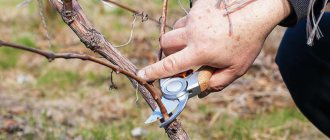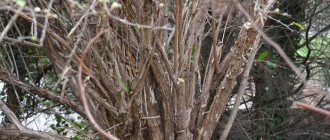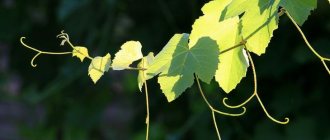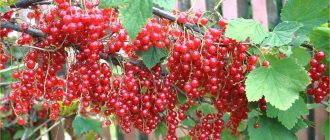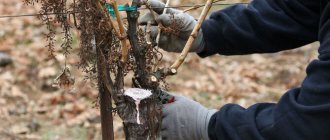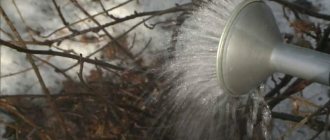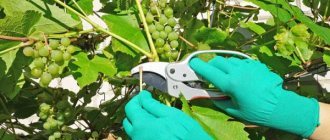Nowadays, in addition to local varieties, stores also sell exotic berries and fruits of amazing shape and taste. But it's fun. Summer residents know that the results of their own labor are preferable in terms of taste, benefits and beauty. The most common and rewarding crop in the area is currants. That's why gardeners are looking for new varieties, planting bushes, pruning shoots, forming the crown so that it is pleasant to look at and convenient to pick berries. After all, the process of caring for and monitoring the development of plants is no less important and interesting than harvesting fruits.
- 2 Which branches of red currant need to be trimmed
- 3 Pruning red currants in autumn
3.1 Video: autumn pruning of red currants
- 4.1 Video: spring processing and pruning of red currant bushes
- 5.1 Anti-aging pruning
5.1.1 Video: anti-aging pruning of red currants
Do I need to prune red currants?
Overgrown currant bushes can be found in abandoned areas. And if in early spring they delight with clusters of elegant flowers, in summer there are only rare small berries on the branches, and the bushes themselves most often look sick and pitiful. Currant plantings need care, as they love lighting and fertilizing, as well as access to air, so that pests and diseases do not develop in shaded and dense thickets. Pruning regulates growth and shapes the crown, and also heals and rejuvenates the bushes. Indeed, with a decrease in the total number of shoots, the plant gives up its strength in a targeted manner, while the cluster develops in favorable conditions, and berries are formed that are exceptional in taste and size.
Well-groomed red currant bushes produce an excellent harvest
Care after pruning
For preventive purposes, it would not hurt to treat the crown with a solution of Bordeaux mixture, which helps against many fungal diseases. Spraying is carried out to prevent the development of rust, spotting, and powdery mildew, which is annoying to many gardeners. For prevention, a 3% solution is used in the spring, and 1% during the growing season and autumn. A properly prepared product will leave a thin bluish film on the leaf blades after treatment. For convenience, it is better to purchase a ready-made mixture and dilute it according to the instructions indicated on the package.
Video with rules of care after fruiting.
In autumn, granular potassium-phosphorus fertilizers are added under the bush. In May, the root system will begin to actively absorb nutrients, increasing the quantity and quality of fruits. It is better to apply chicken manure and mullein before frost, so as not to provoke the growth of young shoots. Add organic matter, 25 cm from the last stems. To avoid burns, it is better to use humus.
You can and should prune currants every year. Even a thickened bush can be saved by removing old shoots. Regular spring, autumn and summer pruning is the key to long and stable fruiting of any type of currant.
Which red currant branches need to be pruned?
Before we start pruning, let's figure out which branches the bush needs and which ones interfere with growth and fruiting. The lightest shoots extending from the roots are zero, otherwise they are called renewal shoots or first-order shoots. In the first year they are straight and do not branch. By the second year of life, lateral branches appear on them - shoots of the second year, etc. The shoots grow especially rapidly in the first three years, then their growth slows down and fruiting decreases. To constantly stimulate the growth of new shoots, shoots of the second and subsequent orders are pruned.
Before you start pruning the red currant bush, determine which shoots need to be removed
However, you should not get too carried away with pruning, otherwise top shoots may form - vertically located branches that appear on the perennial wood of old skeletal branches. They are characterized by intensive growth and weak branching. If there are not enough zero shoots to rejuvenate the bush, you can cut off the old branches not completely, but only to the top shoot, which is then shortened to a suitable outer bud to stimulate branching.
Berries do not grow on top shoots, and the bush takes a lot of effort to develop them
Fruit buds on red currants are formed mainly at the tip of the shoots. Therefore, when pruning, there is no need to shorten all branches: fewer fruit buds are formed on older branches, so shoots older than 4–5 years are cut out.
When pruning red currants, remove the upper parts of the shoots to preserve the fruit buds
How to rejuvenate old currants?
Rejuvenation of an old bush with red or white berries can be carried out at 6-8 years of age. By this time, lignified branches appear, which rarely form berries. The optimal number of shoots on an adult shrub is 20. All branches older than 8 years are cut to the root. They only take away the vitality of the plant. For example, 4-5 year old branches have to be cut out from black.
In the spring, it is necessary to clear the bush of old shoots, frozen and dried parts, and cut off growth spreading along the ground.
How to work with young shoots and 2-4 year growth? Focus on 2 criteria:
- Several skeletal shoots are left, and young shoots are cut off.
- On branches under 4 years old there should be up to 4 active buds.
Pruning neglected bushes is carried out according to the same rules as the rejuvenating procedure. First, thinning, eliminating damaged parts. There is no need to spare unproductive branches; it is enough to leave 3-4 strong central shoots, and cut off the rest in the fall. If the yield does not increase, you need to trim or remove some of the branches completely.
Video: mulching red currants in autumn
All this is done in order to enjoy their own berries at the end of the season. Although the season ends not with harvesting, but with preparing the site for winter. And then there is spring and new troubles.
For the pleasure of eating delicious jelly or fresh juicy red currant berries, you have to plant bushes, water them, care for them, and prune them. But this work brings joy to gardeners and brings fruit.
- Author: Armenuhi Poghosyan
Hello! There are so many different topics in the world! I hope that by collaborating with this site I can share my thoughts and knowledge with others. Rate this article:
- 5
- 4
- 3
- 2
- 1
(37 votes, average: 4.1 out of 5)
Share with your friends!
When and how to prune a currant bush correctly?
Haircut can be done in spring, autumn or summer. When choosing the timing for gardening work, they focus on the periods of vegetative development of the plant. Sanitation procedures usually occur in early spring (March, April). All dried, broken, rotten and frozen branches must be removed. It is important to carry out cleaning before the juice begins to flow, while the fruit crop is dormant. If you prune a blooming plant, it will weaken.
Young shoots have lighter bark
What happens if you are late with pruning before flowering:
- The juice released from the wounds will interfere with their healing.
- The likelihood of pests and fungi penetrating into the shoot tissue will increase.
- The growth of green mass and the appearance of ovaries will slow down.
Is it possible to prune currants in summer?
The tops of skeletal shoots of black currant are cut off to stimulate branching, bud formation, and active fruiting for the next season. This should not be done with red and white ones, since the bulk of flowering buds are formed at the ends of the shoots (with the exception of modern varieties).
In June, repeated sanitary pruning is allowed if the spring turned out to be cold. Remove all poorly growing and damaged shoots. If in the spring they are difficult to detect on a dormant shrub, then in early June poorly growing shoots become more noticeable.
Thinning is planned for the end of summer. The branches that thicken the bush are cut out strictly after harvesting in August. On the one hand, this procedure improves the illumination of the plant, on the other, it weakens the crop. In summer, currants begin to spend energy on forming bark and preparing for winter, and pruning stimulates the appearance of new growths, so you should not remove many branches after fruiting.
If you managed to cope with the currant bushes, then you should think about how to feed the raspberries so that they bear fruit abundantly.
In the video, Lyudmila Chebotar shares her experience.
The main formative and rejuvenating pruning occurs in autumn. In warm climates, sanitary care is postponed until autumn. In cold regions in the spring, not only sanitary, but also formative and rejuvenating procedures are carried out.
Formation of currants from the first year of planting
For the work you will need a traditional or bypass pruner, a hedge trimmer, and garden shears. All instruments must be sharpened and disinfected. You can treat the blades with a weak solution of potassium permanganate or alcohol. It is good if all objects are narrow, so that when working in the center of the bush, the likelihood of damaging branches that cannot be removed is minimal.
All sections are made 1 cm above the kidney at an angle of 45°.
Before pruning the bush in the spring, you need to conduct an inspection. For beginning gardeners, here are the simplest rules:
Gardening scissors
- The first cutting is recommended to be carried out at the stage of planting the seedling in open ground. All sprouts are cut off at the level of the third bud. Such a radical measure contributes to the correct formation of the crown. In a year, the bush will have 5-6 young strong shoots.
- From the 2nd year of life, the formation of currants continues. Cut off all zero growths, leaving 3-5 central ones. Red currants produce less growth, so there is nothing to worry about if you only have to cut off a couple of branches.
- In the 3rd and 4th years, the formation is repeated according to the same pattern, but 6 shoots are left. All young growths shorter than 15 cm are cut out.
- To achieve the correct spherical crown, monitor the appearance of growth directed towards the center of the bush. Such shoots are removed in a timely manner. When pruning the remaining branches, the rule is to leave 3 buds on each branch.
- By the age of 5, the bush may consist of 15-20 shoots.
Scheme of formative pruning
The 1-2 year old branches remaining after cutting are used for rooting. Preparations are cut from productive bushes. When propagating currants by cuttings, it is possible to obtain many acclimatized perennials for yourself and for sale.
After pruning, all tools are disinfected again, the cuts are lubricated with garden varnish so that the wounds heal faster and harmful microorganisms do not penetrate inside the plant.
Autumn haircut
In September and October, formative pruning is preferable for black currants; spring time is preferable for other varieties. It is better to postpone the rejuvenation of all varieties until autumn. Shoots are removed during leaf fall, but before frost occurs. This way the bush will have time to adapt to the drop in temperature and survive the winter safely. If you are late and trim the bush after all the leaves have fallen, the risk of disease will increase. On a still green shrub, after untimely cutting, the buds may become activated in the fall, and this can lead to their death in the winter cold.
Loosening the tree trunk circle after autumn work
Care for a good harvest
In order for the plant to go into winter stronger, it needs to be fed after the autumn shoots are removed. Since currant growth is minimal at this time, it is not necessary to apply nitrogen fertilizers. You should limit yourself only to the use of phosphorus and potassium preparations. Fertilization with organic matter is allowed: chicken manure, mullein or compost.
After fertilizing, the garden crop needs to be watered, especially if there has been no natural precipitation for a long time. This will help the absorption of nutrients. After 2-3 days, the crust that has formed on the ground must be destroyed by loosening the soil between the rows.
These procedures will increase the yield of currants next year and prepare the garden crop for active spring growth.
Attention! If you mulch the soil between the rows of currants, this will help retain moisture in the soil and prevent crust formation after watering.
Aesthetic formation of the bush
Properly formed currant bushes not only look attractive. Thinned plants are better illuminated by sunlight, which speeds up the ripening of berries, making them easier to harvest.
The following formation methods are distinguished:
- Bushy. This is the most common type of currant formation. In this case, 15-20 shoots are left, which are renewed every 6-7 years.
- Standard. With this method, one main central process is formed. At the required height, during autumn pruning, all buds are removed and 4 shoots are left. Later, when the plant reaches three years of age, the root shoots are removed. This type of currant formation is preferable in regions with warm climates.
- Along the cordon. Immediately after planting, currant shoots are cut in half. Subsequently, an annual growth of 15 cm is left on the central branch, and the lateral shoots are removed with a remainder of 2-3 cm. The result is one central powerful conductor with lateral fruit-bearing layers.
- On the trellis. One central conductor is formed with side branches, which form several tiers. The height of the plant in this case reaches 1.5 m with four lateral tiers.
Attention! Currant bushes on a trellis are better pollinated, it is easier to harvest berries from them, and the row spacing is more convenient to process.
Timing for pruning
Experienced gardeners recommend performing exclusively sanitary pruning of currants after harvesting. The exact timing of the procedure is not provided; it is better to focus on the climatic characteristics of the growing region.
Reference. The procedure is performed in dry weather. Dry and sun-warmed shoots are easier to prune.
The approximate timing of pruning after fruiting is from July to September. In the south, the procedure is performed from mid-June to early July, in the northern and central regions - from August.
Favorable days
Adherents of gardening according to the phases of the moon advise adhering to the lunar calendar.
Favorable days for pruning currants in 2020:
- June: 1–6, 8, 12, 13, 17–19, 22, 23, 26–28, 30;
- July: 1–3, 7–12, 14–18, 22–31;
- August: 1, 2, 6, 7, 10–16, 20–26, 28, 29;
- September: 1–3, 6–13, 18–24, 29, 30.
Favorable days for pruning in 2022:
- June: 2, 3, 6–8, 11–13, 16, 19–25, 29, 30;
- July: 4–8, 13–17, 19–23, 27, 28, 31;
- August: 1–6, 10–15, 17–19, 23, 27–31;
- September: 1–3, 8–13, 15, 16, 19, 20, 24–30.
Removing a currant branch to soil level
It is used to completely remove an old branch, which is cut in such a way that no stump remains above the soil. This is important, since the remaining dead part will either begin to rot or become a convenient entry point for pests. To make the correct cut, the ground is shifted slightly and the branch is removed with pruning shears.
Kinds
The classification is based on the purpose of pruning. The following varieties are distinguished:
- Formative. Its goal is to give the bush a neat, attractive shape. Most often relevant for young plants.
- Sanitary. This involves removing weak, broken, dried branches affected by pests or shoot diseases. After winter, frozen shoots are removed. The shoots, fatty shoots are destroyed,
- Rejuvenating. The following signs indicate the need for it: decreased yield, weak growth, poor flowering. It is recommended to completely remove old shoots.
- Restorative. It is used when the bush freezes, and also if it is neglected, then it also includes the formative stage.
Thinning out forks to side branches
On currants, like on other shrubs and trees, many forks form. They thicken the crown, preventing light from penetrating inside. Thinning the branches solves this problem. In such cases, trimming “for translation” is used. This means that out of two branches, one is left, which will take the juices, thereby increasing the likelihood of fruiting. The main rule for choosing a branch to remove is the direction of growth: if the shoot grows vertically upward, it cannot be left.
Tools and equipment
To carry out this you will need sharply sharpened and disinfected instruments:
- Garden knife. Used for straight cuts of thin branches.
- Secateurs. Removes shoots of medium thickness.
- Hacksaw with small teeth. Removes the thickest branches of the bush.
- Brush cutter. Used to form a bush.
- Lopper. Thanks to the long handles, the date allows you to reach hard-to-reach places.
Mistakes when growing plants
When cultivating red currants, beginners often make the following mistakes:
- Only old shoots are removed. Red currants grow quickly, so young branches must also be pruned in order to give the bush the required shape in advance.
- Only the tops of the branches are removed. At the same time, the plants thicken excessively, which leads to a decrease in their yield and late ripening of berries due to lack of sunlight.
- They leave too many shoots. Nutrients are spent on their support, although not all branches bear fruit equally. Only strong, healthy shoots should be left.
- They ignore the timing of events. Work not done on time can negatively affect the fruiting of the bush next year, so activities must be completed on time.
Pruning currant bushes is a necessary procedure when growing this plant. Without it, it is impossible to properly form a bush and unlock the productivity potential of a particular variety of garden crop.
Rate this post
